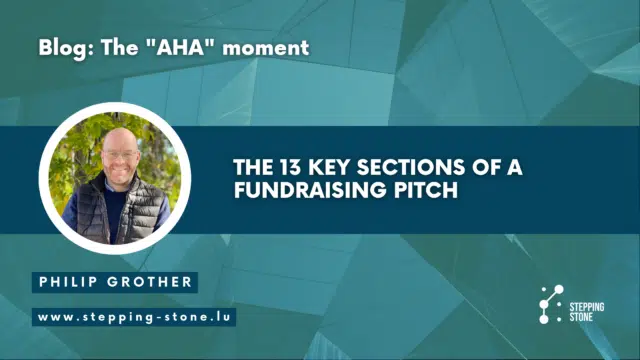At some point during your fundraising process, you’ll have to pitch in front of investors, so we’re going to explore together what are the different sections in a fundraising pitch. The following applies to fundraising, and it can be adapted to most presentations.
From one presentation to another, what changes is our intention with the pitch, and what we want our audience to do when we have finished presenting. For fundraising, for example, your intention is for your audience to invest in your venture, so you need to provide:
Powerful introduction
You have 15 seconds to captivate our audience’s attention, so you need to start strong with an impactful story, or a key fact, that will trigger a certain emotion. When you tell a story, you can use the narrative as an anchor point throughout your entire presentation. Your main objective with your powerful introduction is to get your audience to use their imagination, in doing so, they will connect at a much deeper level.
Problem
Your venture exists to add value, and generally, that value will be generated by solving a problem. Your audience needs to understand why this is a problem worth solving, if not for everyone, at least for a very clear audience, hopefully some of whom are listening to you speak. You need to explain the problem that you are solving clearly, and for whom, in a way that your audience “gets it”, so storytelling continues to be essential.
Solution
Your solution to the problem should flow naturally in the narrative, always keeping your audience engaged and wanting to find out how you provide value. Whether you are innovating with technology or providing a service, your solution was made to solve a problem for a specific audience with a specific need. Simplicity is your friend because by this stage of your pitch, you want to get your audience to their first “AHA” moment. Clear understanding creates a sense of connection and makes your audience want to carry-on listening.
Market opportunity
As mentioned above, your solution is being provided to solve a problem for a specific audience. If you want to raise funds to grow your venture, the audience for what you are providing needs to be big enough for it to make business and financial sense for your potential investors to get a return on their investment. If the value you provide requires selling at a low price point, you’re going to need a large volume of clients. On the contrary, if your audience is very small and niche, they need to be willing to pay high prices for the value you provide.
Business model
- Business model: Knowing how you are going to make money is the other side of the coin. Investors need to understand that you know how you are going to be compensated for the value you provide, because that will determine how they are going to make a return on their investment. If the business model is unsustainable, too complicated or non-existant, the investment wouldn’t make business or financial sense for anyone involved. If there are multiple sources of revenue, making the flows as clear and simple as possible will allow your audience to understand and follow your logic.
Team
Your investors want to know that their money is going to be in good hands. It’s not impossible to raise funds as a lone ranger or solopreneur, it just means that if something happens to you, the venture stops and the investors loose their money. When there’s a team involved, and hopefully you’ve surrounded yourself with super competent people, it means that you’re not the only one carrying the burden of responsibility. So in your pitch, it doesn’t have to take long, but tell your audience about your amazing team and why they are the superstars that are going to add all the value to your willing and eager clients.
Go-to-market Strategy
Depending what stage your venture is at, and depending on how close you are to product-market fit, you’ll have different go-to-market strategies to explore. In your fundraising pitch, your investors are going to expect to see a clear vision and path to getting your value delivered to the market. The days of “build and the will come” are over, and if even that does still work from time to time, your investors are expecting you not to leave it up to chance. Your go-to-market strategy will also give investors a sense that you understand your target audience at a deeper level.
Competition
If ever you find yourself convinced that there is “no competition” in your field of business, it’s time to ask yourself some serious questions. It could mean that there is no market for what you have to offer. It could mean that the problem simply isn’t big enough for there to be an ROI (return on investment). It could mean that the solution is being solved by other means, through an adjacent product or service. That being said, the reason why you need to include the competitive landscape in your pitch is because investors want to know that you understand how else your clients could solve their burning problem.
Traction
No matter what stage you are at, you need to show that you are tracking your numbers and that you have some form of traction. The following lists are non-exhaustive and are meant to give you an idea of what you could put in the traction section of your pitch. If some of these are not familiar, this also gives you an idea of what you need to do some research on:
- Non-financial metrics:
- Number and frequency of interviews with in-target potential clients
- Conversion rate of potential clients to beta testers
- Number of beta testers
- Conversion rate of beta testers to paying clients
- Number of clients or users
- Client or user growth
- Monthly Active Users
- Size of the engaged community (this is not the number of likes on Facebook…)
- Community growth
- Number of LOIs (letters of Intent) or MOUs (Memorandums of Understanding)
- Whatever you can tell investors that shows that you are talking with the right people and seeking to understand what problems they have
- Financial metrics:
- Runway
- Cash Burn Rate
- Total revenue to date
- MRR = Monthly Recurring Revenue
- ARR = Annual Recurring Revenue
- CAC = Customer Acquisition Cost
- CLV = Customer lifetime value
- ROAS = Return On Ad Spend
- Working Capital
- Payback periods
- Gross, operating and net profit margin
- Net revenue retention
Financial Projections
Combining all of the above, you are going to demonstrate that there is a clear plan to make money going forwards. The investors want to get an understand of how long it’s going to take to get their return on investment, and how you plan to do it. This is a reality check to make sure that the venture is sustainable, and that revenue is going to grow faster than the expenses. Graphs always do a good job at demonstrating how both revenue and expenses change over time. The most common timeline of financial projections is 3 years, but if your venture operates in much longer timescales, it’s important to build that into your narrative so you don’t waste time speaking with the wrong investors.
Funds Requested
As this is a fundraising pitch, you need to tell the audience how much money you are raising. Depending on the stage of your venture, you may want to include the valuation of your company, as this will determine how much of the company the investors will own after they have made their investment. You might also be looking for a loan. In any case, your audience needs to understand what they get in exchange for their money.
Use of funds
The investors need to understand how their money is going to be used. You don’t need to go into too much detail by accounting for every Euro, Dollar, or Pesos. The aim here is to give the audience an understanding that you are not going to use their money to sail around Greek islands for a month. You might want to give more details on a particularly interesting part of the use of funds, maybe one that is going to provide break-through results.
Call to action
Finally, and this applies to ALL presentations – not just fundraising pitches – you must give your audience a clear call to action. If you are raising funds, you need to tell them what the next steps are, for example:
- “To set up a one-on-one meeting with me and my team to talk about your investment in our venture, send me an email on [email protected]”, or
- “To access our data room, please scan the QR code on the screen or go to www.mycompany.com/dataroom and use the password myname1!”.
If you are not fundraising, the same logic applies:
- “To sign-up for ABC, go to www.mycompany.com and click on XYZ button”, or
- “To help us achieve ABC objective, like and share XYZ content on www.socialmedia.com”.
Remember
Each pitch must be adapted to the audience you are presenting in front of, and some of the above might not be relevant to all pitches. You need to understand who your audience is, and what matters to them.
If you have a public speaking engagement of any kind, and you are looking for help to be as prepared as possible for your presentation, contact Philip Grother via this contact form or book a call.


